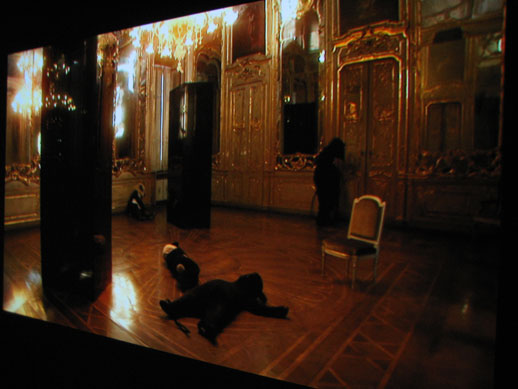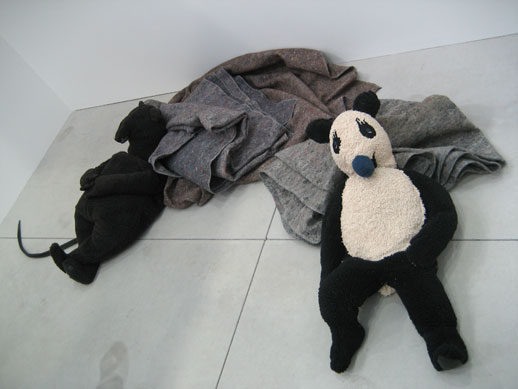Yokohama Triennale 2008: Fischli and Weiss
This time, Fischli and Weiss have three rats and three bears in this video installation, projected on three screens. Human-sized ones, larger grizzly bear-sized ones, and tiny rabbit-sized ones. And in the next room, a fourth rat and bear are lying on the floor sound asleep. It’s a wonder that they are not woken up by the ruckus kicked up by these art tourists and Triennale trekkers.

The first chapter, called The Least Resistance (1981), featured the rat and bear running around Los Angeles while falling into oblique discussions on the art industry. The second chapter, The Right Way (1982), saw the animal duo embark on a Swiss Alpine excursion. In Yokohama, they’ve made their way into an Italian palazzo. But in place of snappy dialogue, Rat and Bear are strangely mute and bewildered! Perhaps they’re afraid to disturb the stateliness of this hallowed setting. They spend much time dallying on the stairs, aimlessly stumbling around the lavish premises; here, admiring the gold cornices and cherubs on the ceiling; there, staring at reflections of themselves in large gilded mirrors.
In one scene, they edge slowly closer to one of the mirrors, dumbstruck, and begin incredulously combing their own fur, stroking their furry faces in wonder, as if shocked to be in their own skin (or fur, as the case may be). Rat and Bear seem to be trapped in a play whose director has suddenly disappeared, and they have forgotten what they should do next. They watch themselves (or larger, or smaller, versions of themselves) wander around an existential toy diorama without a plot, peering curiously into the depths of smoky glass capsules; as the bigger animals stare back. They, too, are players perplexed at their own production.

On another screen, they seem to have escaped the capsules! And so ensues a hilarious game of tag, packed with slapstick gags – the four animals big and small chase each other over an overpolished and slickly varnished floor that makes them slip and fall over. They run backwards, stumble, spin around on their tummies, and at last keel over in exhaustion.
Playacting for Fischli and Weiss holds a genuine old-world enchantment without irony, fleshed out by characters that are closer to the Wind in the Willows than Disneyland. Contrast this to Paul McCarthy’s orgy on a pirate ship video installation, also showing at the Triennale, in which pirate and ogre costumes help to truss up a campy, hammed-up paroxysm of self-conscious role-playing. McCarthy’s costume play functions as a burlesque of a pathologically smiley Disney world with relentlessly jolly characters. He creates a parallel universe of perversity that permits a wide array of grotesque behavior. With orgasm written all over their smarmy faces, the actors treat each other to dramatized therapy sessions, where they achieve a sense of catharsis from repressed sexual desires and violent impulses.
In contrast, while Rat and Bear also have existential problems, they seem authentically absorbed in their non-encounters in the palazzo. Along the way they manage to amuse and even astound themselves, happily trapped in a cabinet of their own wonder. Their approach to life is to wonder at the mechanisms of the world, to scrutinize mundane phenomena, and to dally while doing it – much like Fischli and Weiss themselves, who in this languidly-paced video installation do little more than orchestrate a couple of gags.
Compared to the weightier subject matter tackled by several of the more conceptual video works at the Triennale by artists like Douglas Gordon or Mike Kelley, Parts of a Film seems content just to ponder itself, mutely; to indulge in a bit of floundering, and to enjoy the silliness of a few of its own outtakes. A bit like wandering around the Triennale, actually: with no captions for the works on display, visitors scuttle around slightly bewildered, peering curiously at objects in this carnival of wonders whose directors have neglected to give their players a script.
Darryl Jingwen Wee
Darryl Jingwen Wee



